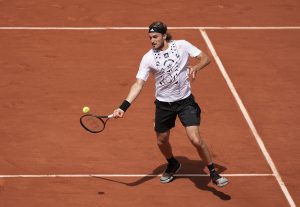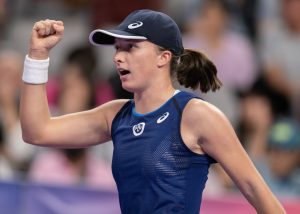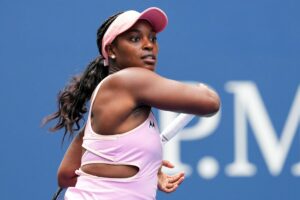At the Moselle Open in Metz, Jo-Wilfried Tsonga has continued his comeback from the injuries and loss of form that have seen him slide down the rankings from his career-high of World No.5 in 2012 to his current ranking of World No.61. The fact that his beaten opponent in the last 16, Pierre-Hugues Herbert, is now ranked above him (at World No.55) shows just how far Tsonga has fallen from the lofty heights of the top five. Nevertheless, he comfortably defeated his French compatriot and fellow 2017 Davis Cup winner to show that he might just be starting a return to the highest echelons of the game.
The match-up between Tsonga and Herbert was a classic case of, in boxing parlance, a good big ‘un beating a good little ‘un. Tsonga, because of his considerable facial similarity to the young Muhammad Ali, has always invited the use of boxing imagery to describe him, but the last 16 contest in Metz really was a case of a heavyweight (or at least middleweight) beating up a lightweight (or welterweight, if the term “lightweight” is too pejorative).
As in their previous three encounters, Herbert could not even win a set against Tsonga, let alone the entire match. Herbert, of course, is one of the finest doubles players in the world, usually alongside Nicolas Mahut, with whom he has won several Major doubles titles. However, in singles he just lacks the “weapons” (typically a fast serve and fast groundstrokes) that the top players, such as Tsonga at his best, possess in abundance.
That was particularly evident in an early exchange in the second set, when Tsonga and Herbert played out a fabulous (and typically French, as in flair-filled) rally. Tsonga was fighting to hang onto his serve after breaking Herbert in the first game of the set, and so he fired a succession of increasingly wide-angled forehands at Herbert. Herbert somehow returned them all, the final one from virtually the front row of the spectators’ seats, but Tsonga finally won the point and with it backed up the break of serve. He then won the second set relatively comfortably, to secure yet another straight-sets win over Herbert.
Where next for Tsonga? Well, in the immediate term he will face Nikoloz Basilashvili in the Metz quarterfinal. In recent seasons, Basilashvili has been making the exact opposite journey in the rankings to that of Tsonga, such that he is currently ranked at World No.17. Although the Georgian is yet to make any significant inroads at a Grand Slam tournament (so far he has not been beyond the fourth round at any of the four Majors), he has undoubtedly been one of the form players of the 2019 season, as he emphatically demonstrated on the clay of Hamburg, when he retained the title that he had first won last year.
A Tsonga-Basilashvili match has the potential to be a minor classic, as both men combine power and flair in almost equal measure. Although Basilashvili has undoubtedly been in better form recently than Tsonga, in a tournament on home soil (or at least on a home indoor hard surface) and thus with the backing of the home fans behind him, Tsonga can certainly overturn his deficiencies in both the rankings and current form.
Incidentally, given how well French players perform in other tournaments in France (there are three other French players beside Tsonga in the last eight at Metz), it remains something of a mystery as to why collectively they usually perform so poorly at Roland Garros. Of course, Tsonga is perhaps the classic example of that, having meekly lost his 2013 French Open semi-final against David Ferrer, when he was the favourite to become the first Frenchman to reach the final of their home Major since Yannick Noah in 1983.
Whatever happens now with Tsonga, it is of course extremely unlikely that he will scale those kinds of heights again. He is already 34 and the increasing incidence of injuries that he has suffered recently is evidence of the inevitable physical decline that age brings. That prompts the question: how long will he continue on the comeback trail, especially if it is probable that he will no longer scale the heights that he has reached before?
The answer to that question might just be found by considering the influence of the Big Three of Federer, Djokovic and Nadal on other less gifted players of this era. On the one hand, “Fedalic” collectively show that it is now possible for a top player, if he is fully motivated, to continue playing at an astonishing high level well into his late thirties. On the other hand, the very fact that they are all still performing so well at such a great age (at least compared to that of most male tennis players before them) provides a constant reminder that the lesser lights on tour are unlikely to overtake them, even at the end of their careers.
By any normal, reasonable standard, Tsonga has had a spectacular career, not only reaching the world’s top five but a Grand Slam Final (the 2008 Australian Open final, which he lost to Djokovic) and winning the Davis Cup for France in 2017, when he was a key component of the French team (playing two singles matches and winning one against Belgium). Perhaps even more importantly, it is conservatively estimated that he has won at least $US 20 million, which is considerable compensation for the pain of never winning a Major. Given that kind of money in the bank, and the increasing number of injuries that he is suffering now he is in his mid-30s, Tsonga would not be human if he did not wonder, even occasionally, exactly what more he has left to give to the game.
If, ultimately, Tsonga’s comeback trail does not lead him back to the top of the game (and the chances are that it will not), he can still take considerable comfort from those achievements, and the fact that in almost any other era but this one he would surely have made more than one Major final, and perhaps even won a Major.
In that respect (and I hope readers will forgive a final boxing analogy), Tsonga may ultimately come to be regarded as the tennis equivalent of a Wilfred Benítez, the superb Puerto Rican boxer who was one of the slightly lesser lights in the legendary middleweight era of the 1980s. In fact, Tsonga may eventually be rated more highly in his sport than Benítez is in boxing. After all, Benítez only had to contend with the fabled “Four Kings” of Hagler, Leonard, Duran and Hearns. By contrast, Tsonga, like every other male player of the last 15 years, has had to contend with the “Three Gods” of tennis.
Main Photo from Getty.






